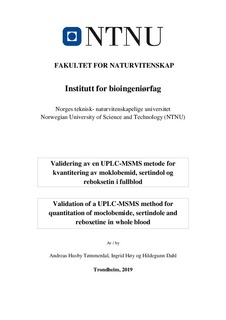| dc.description.abstract | Hensikten med prosjektet er å validere en ny metode for analyse av moklobemid, sertindol og reboksetin (MOSER) i fullblod ved Avdeling for klinisk farmakologi St. Olavs hospital. Den nye metoden skal erstatte tre gamle metoder for analyttene, hvor de ble analysert på HPLC-MS. Den nye metoden benytter færre helseskadelige stoffer, og er mer effektiv ettersom de tre analyttene kan analyseres i én samlet metode. Da den nye metoden benytter UPLC-MSMS, er den også mer sensitiv enn forgjengeren. I tillegg er det ønskelig å undersøke om det kan benyttes standarder løst i serummatriks til kalibrering, fremfor standarder i blodmatriks. Dette for å gjøre opparbeidingen av standarder enklere og mer effektiv for avdelingen.
For å validere den nye metoden for MOSER i fullblod, ble det gjort forsøk for å undersøke metodens signal-til-støy forhold, nedre kvantifiseringsgrense, repeterbarhet, reproduserbarhet og holdbarhet. I tillegg ble det gjort forsøk for å sjekke analysens ekstraksjonsutbytte, og holdbarheten til analyttene ved gjentatt frysing og tining.
Ut ifra resultatene for nedre kvantifiseringsgrense ble det vurdert at de samme konsentrasjonsnivåene kan benyttes i den laveste standarden for MOSER-analyttene i fullblodmetoden, som i serummetoden. Beregninger viste at standarder i serummatriks ga god linearitet og god riktighet og derfor kan implementeres som standardrekke i MOSER i fullblod. Resultatene for innen serie variasjon og mellom serie variasjon viste at metoden har god repeterbarhet og reproduserbarhet. Holdbarhetsundersøkelsen bekreftet god stabilitet i opptil tre dager for analyttene i opparbeidede prøver. Resultatene fra beregningene for ekstraksjonsutbytte viste verdier innenfor akseptkriteriet, og høyere utbytte for moklobemid og reboksetin i MOSER i fullblod sammenlignet med serummetoden. Holdbarheten ved gjentatt tining og frysing viste stabile verdier.
Den nye metoden for MOSER i fullblod er dermed egnet til bestemmelse av analyttene moklobemid, sertindol og reboksetin i postmortale prøver. Standarder og kontroller i serummatriks kan erstatte standarder og kontroller i blodmatriks. | |
| dc.description.abstract | The purpose of this project was to validate a new method for analyzing moclobemide, sertindole, and reboxetine (MOSER) in whole blood samples, for the department of clinical pharmacology at St. Olav's hospital. The new method will be replacing three former methods for these analytes, where the analysis was performed on HPLC-MS. By implementing the new whole blood method for MOSER, fewer health-hazardous substances will be used in the analysis. The analysis will also become more efficient since all three analytes can be analyzed in one collective method. By using UPLC-MSMS the new method will also be more sensitive than its precursor. In addition, tests will be done to check if standards in serum matrix can be used to calibrate the new method, rather than whole blood standards. This is done in order to simplify the preparation of standards and to make the procedure more efficient for the department.
For the validation, several tests were done to determine signal-to-noise ratio, limit of quantification, repeatability, reproducibility, and durability for the method. In addition, tests were conducted to determine the extraction yield of the analysis, and the durability of the analytes through repeated freezing and thawing.
The signal-to-noise ratio results were used to evaluate the selectivity of the method in whole blood. Results from this test showed that the standard of the lowest concentration for MOSER in serum, could be used for MOSER in whole blood. Results also showed that standards in serum matrix yields good linearity and trueness, and that standards in serum matrix could be used to calibrate the whole blood method for MOSER. Within-run precision and between-run precision results showed good repeatability and reproducibility for the method, and the stability tests confirmed that the analytes were stable for up to three days after sample preparation. Recovery results were within the requirements of the department. In addition, the recovery for moclobemide and reboxetine was improved using the whole blood method, compared to the serum method. The stability of the analytes through repeated freezing and thawing was also acceptable.
MOSER in whole blood is thus suitable for analysis of moclobemide, sertindole, and reboxetine in postmortal blood samples. Standards and controls in serum matrix are suitable to replace standards and controls in blood matrix for this method. | |
